HI6005 Management and Organisations: Globalisation, Culture Analysis
VerifiedAdded on 2023/06/13
|9
|1822
|184
Essay
AI Summary
This essay examines globalization through Thomas Friedman's lens, highlighting its drawbacks and questioning the 'flat world' concept, particularly for small enterprises. It contrasts Australian and Brazilian cultures using Hofstede's five cultural dimensions (power distance, individualism, masculinity, uncertainty avoidance, and long-term orientation), revealing significant differences. The analysis agrees with Hofstede's survey results for Australian culture, emphasizing its individualistic nature and low power distance. The essay concludes that globalization's impact is not uniform due to political, social, and cultural variations, and that Friedman's analysis overlooks the opportunities available to small businesses in a globalized world. The essay also highlights the potential for globalization to transfer investment and jobs from developed to developing nations, presenting both challenges and opportunities.
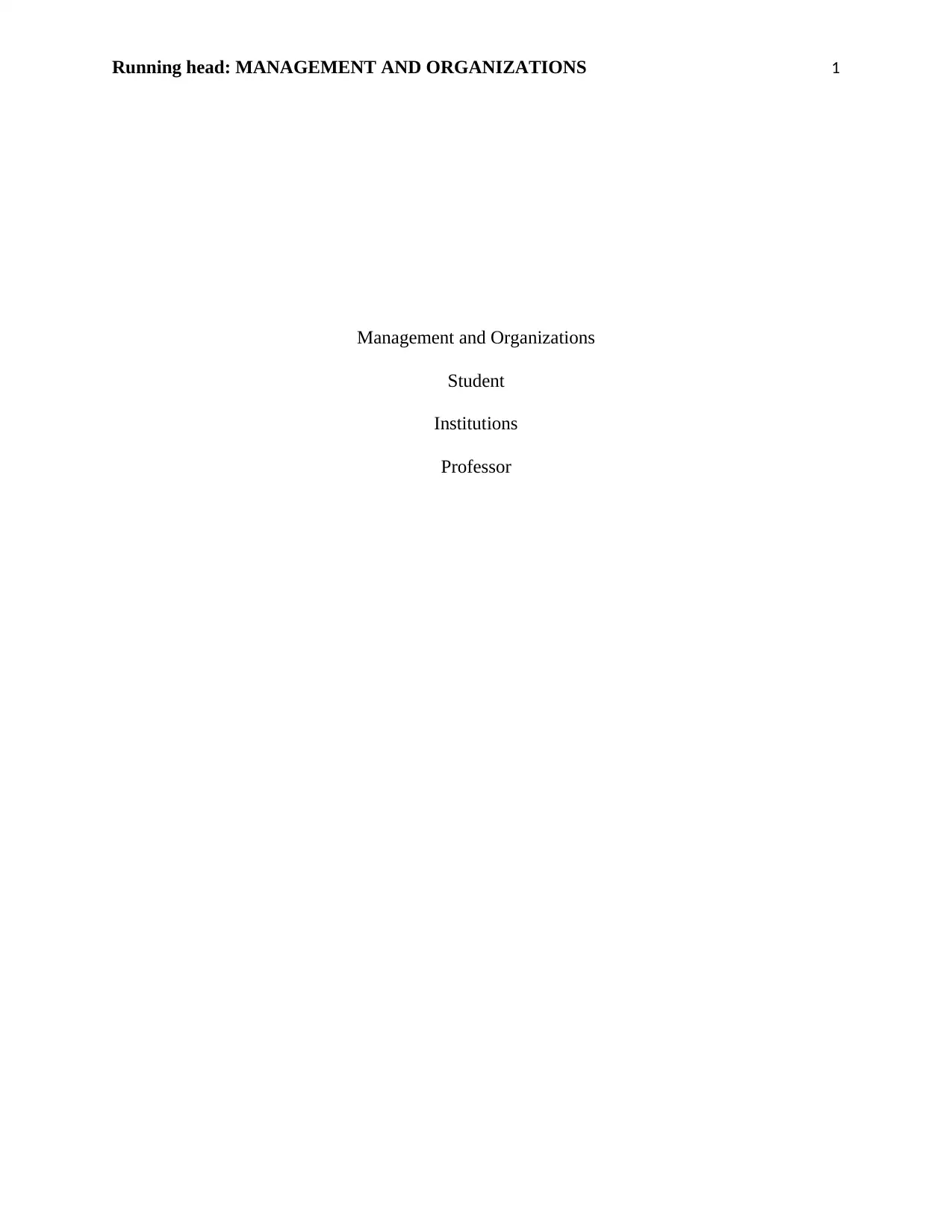
Running head: MANAGEMENT AND ORGANIZATIONS 1
Management and Organizations
Student
Institutions
Professor
Management and Organizations
Student
Institutions
Professor
Paraphrase This Document
Need a fresh take? Get an instant paraphrase of this document with our AI Paraphraser
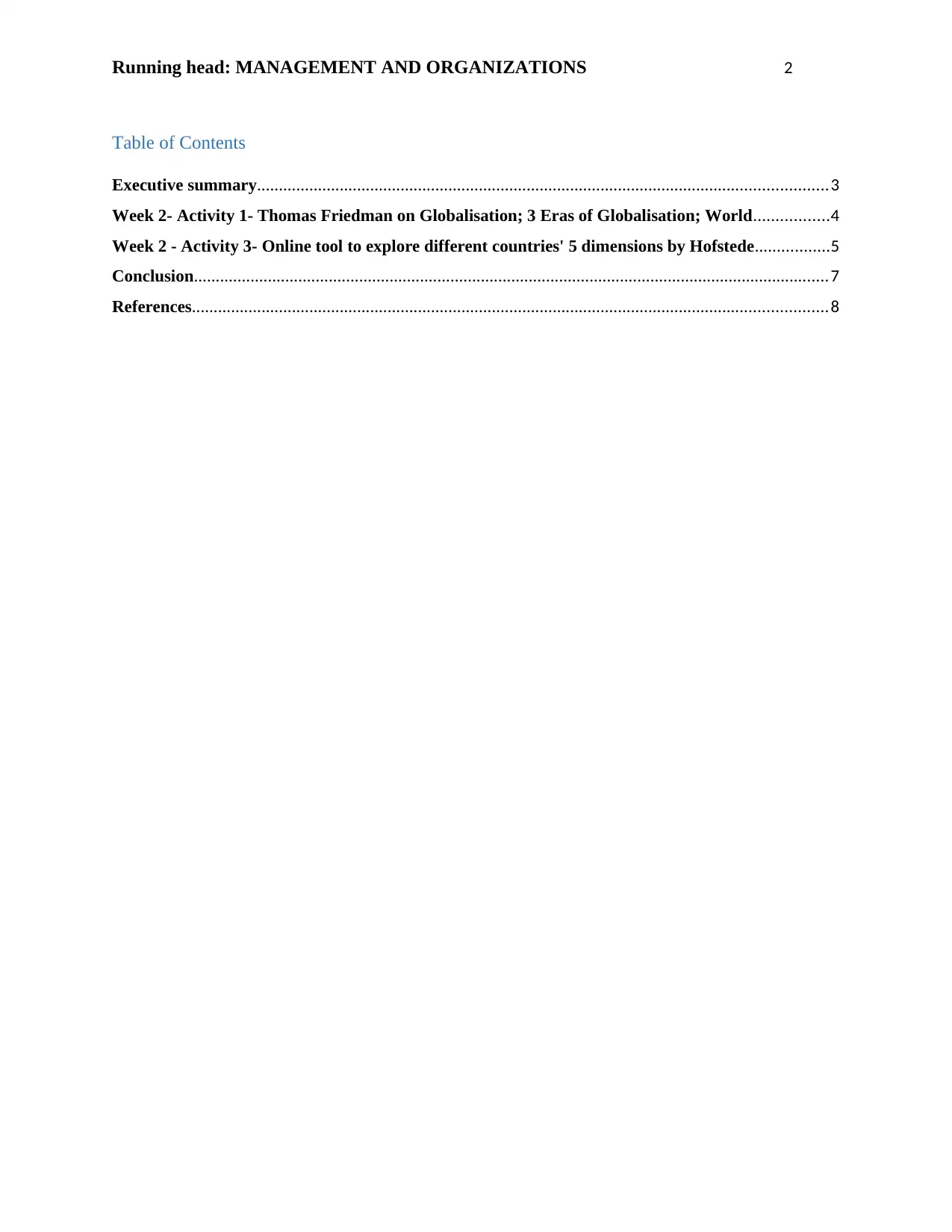
Running head: MANAGEMENT AND ORGANIZATIONS 2
Table of Contents
Executive summary...................................................................................................................................3
Week 2- Activity 1- Thomas Friedman on Globalisation; 3 Eras of Globalisation; World.................4
Week 2 - Activity 3- Online tool to explore different countries' 5 dimensions by Hofstede.................5
Conclusion..................................................................................................................................................7
References..................................................................................................................................................8
Table of Contents
Executive summary...................................................................................................................................3
Week 2- Activity 1- Thomas Friedman on Globalisation; 3 Eras of Globalisation; World.................4
Week 2 - Activity 3- Online tool to explore different countries' 5 dimensions by Hofstede.................5
Conclusion..................................................................................................................................................7
References..................................................................................................................................................8
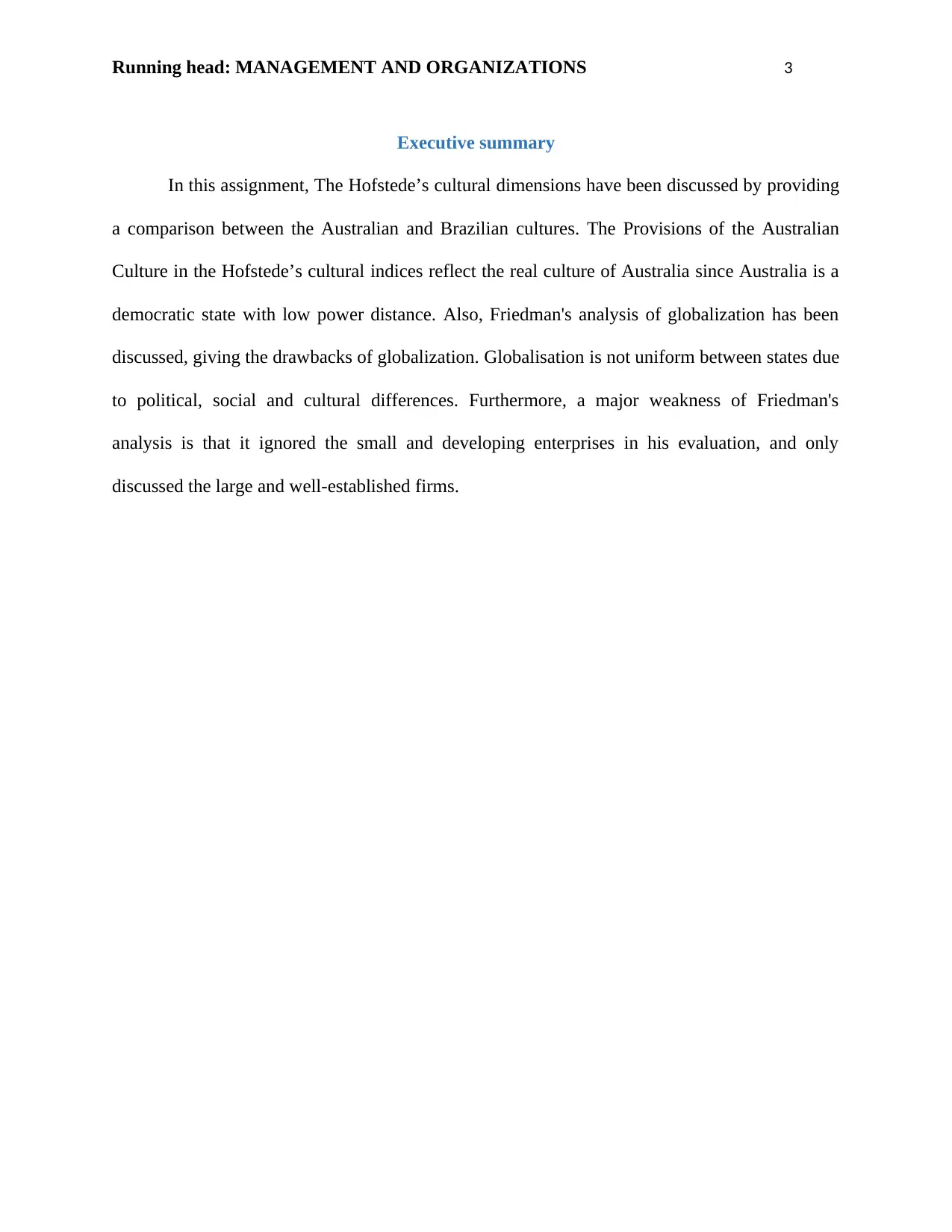
Running head: MANAGEMENT AND ORGANIZATIONS 3
Executive summary
In this assignment, The Hofstede’s cultural dimensions have been discussed by providing
a comparison between the Australian and Brazilian cultures. The Provisions of the Australian
Culture in the Hofstede’s cultural indices reflect the real culture of Australia since Australia is a
democratic state with low power distance. Also, Friedman's analysis of globalization has been
discussed, giving the drawbacks of globalization. Globalisation is not uniform between states due
to political, social and cultural differences. Furthermore, a major weakness of Friedman's
analysis is that it ignored the small and developing enterprises in his evaluation, and only
discussed the large and well-established firms.
Executive summary
In this assignment, The Hofstede’s cultural dimensions have been discussed by providing
a comparison between the Australian and Brazilian cultures. The Provisions of the Australian
Culture in the Hofstede’s cultural indices reflect the real culture of Australia since Australia is a
democratic state with low power distance. Also, Friedman's analysis of globalization has been
discussed, giving the drawbacks of globalization. Globalisation is not uniform between states due
to political, social and cultural differences. Furthermore, a major weakness of Friedman's
analysis is that it ignored the small and developing enterprises in his evaluation, and only
discussed the large and well-established firms.
⊘ This is a preview!⊘
Do you want full access?
Subscribe today to unlock all pages.

Trusted by 1+ million students worldwide
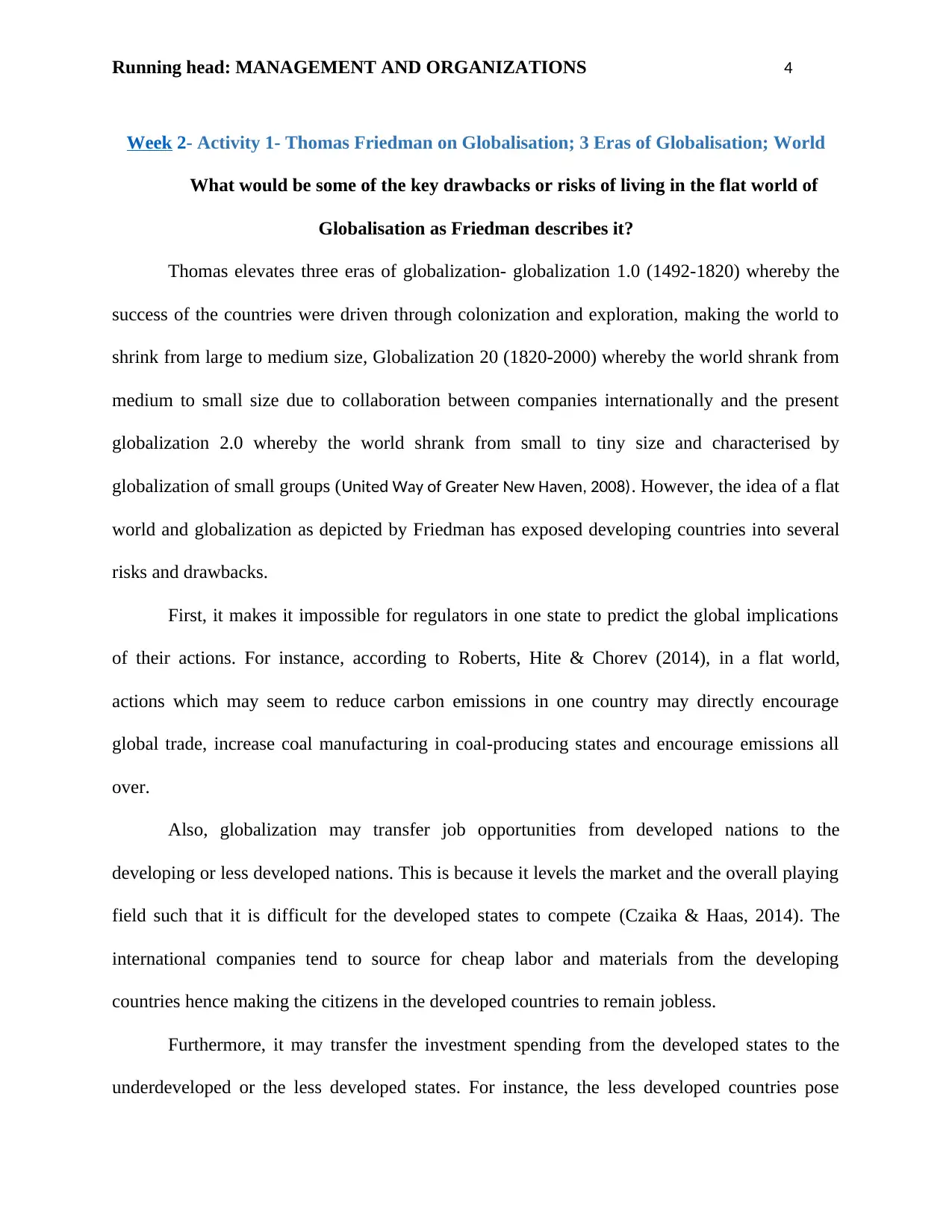
Running head: MANAGEMENT AND ORGANIZATIONS 4
Week 2- Activity 1- Thomas Friedman on Globalisation; 3 Eras of Globalisation; World
What would be some of the key drawbacks or risks of living in the flat world of
Globalisation as Friedman describes it?
Thomas elevates three eras of globalization- globalization 1.0 (1492-1820) whereby the
success of the countries were driven through colonization and exploration, making the world to
shrink from large to medium size, Globalization 20 (1820-2000) whereby the world shrank from
medium to small size due to collaboration between companies internationally and the present
globalization 2.0 whereby the world shrank from small to tiny size and characterised by
globalization of small groups (United Way of Greater New Haven, 2008). However, the idea of a flat
world and globalization as depicted by Friedman has exposed developing countries into several
risks and drawbacks.
First, it makes it impossible for regulators in one state to predict the global implications
of their actions. For instance, according to Roberts, Hite & Chorev (2014), in a flat world,
actions which may seem to reduce carbon emissions in one country may directly encourage
global trade, increase coal manufacturing in coal-producing states and encourage emissions all
over.
Also, globalization may transfer job opportunities from developed nations to the
developing or less developed nations. This is because it levels the market and the overall playing
field such that it is difficult for the developed states to compete (Czaika & Haas, 2014). The
international companies tend to source for cheap labor and materials from the developing
countries hence making the citizens in the developed countries to remain jobless.
Furthermore, it may transfer the investment spending from the developed states to the
underdeveloped or the less developed states. For instance, the less developed countries pose
Week 2- Activity 1- Thomas Friedman on Globalisation; 3 Eras of Globalisation; World
What would be some of the key drawbacks or risks of living in the flat world of
Globalisation as Friedman describes it?
Thomas elevates three eras of globalization- globalization 1.0 (1492-1820) whereby the
success of the countries were driven through colonization and exploration, making the world to
shrink from large to medium size, Globalization 20 (1820-2000) whereby the world shrank from
medium to small size due to collaboration between companies internationally and the present
globalization 2.0 whereby the world shrank from small to tiny size and characterised by
globalization of small groups (United Way of Greater New Haven, 2008). However, the idea of a flat
world and globalization as depicted by Friedman has exposed developing countries into several
risks and drawbacks.
First, it makes it impossible for regulators in one state to predict the global implications
of their actions. For instance, according to Roberts, Hite & Chorev (2014), in a flat world,
actions which may seem to reduce carbon emissions in one country may directly encourage
global trade, increase coal manufacturing in coal-producing states and encourage emissions all
over.
Also, globalization may transfer job opportunities from developed nations to the
developing or less developed nations. This is because it levels the market and the overall playing
field such that it is difficult for the developed states to compete (Czaika & Haas, 2014). The
international companies tend to source for cheap labor and materials from the developing
countries hence making the citizens in the developed countries to remain jobless.
Furthermore, it may transfer the investment spending from the developed states to the
underdeveloped or the less developed states. For instance, the less developed countries pose
Paraphrase This Document
Need a fresh take? Get an instant paraphrase of this document with our AI Paraphraser
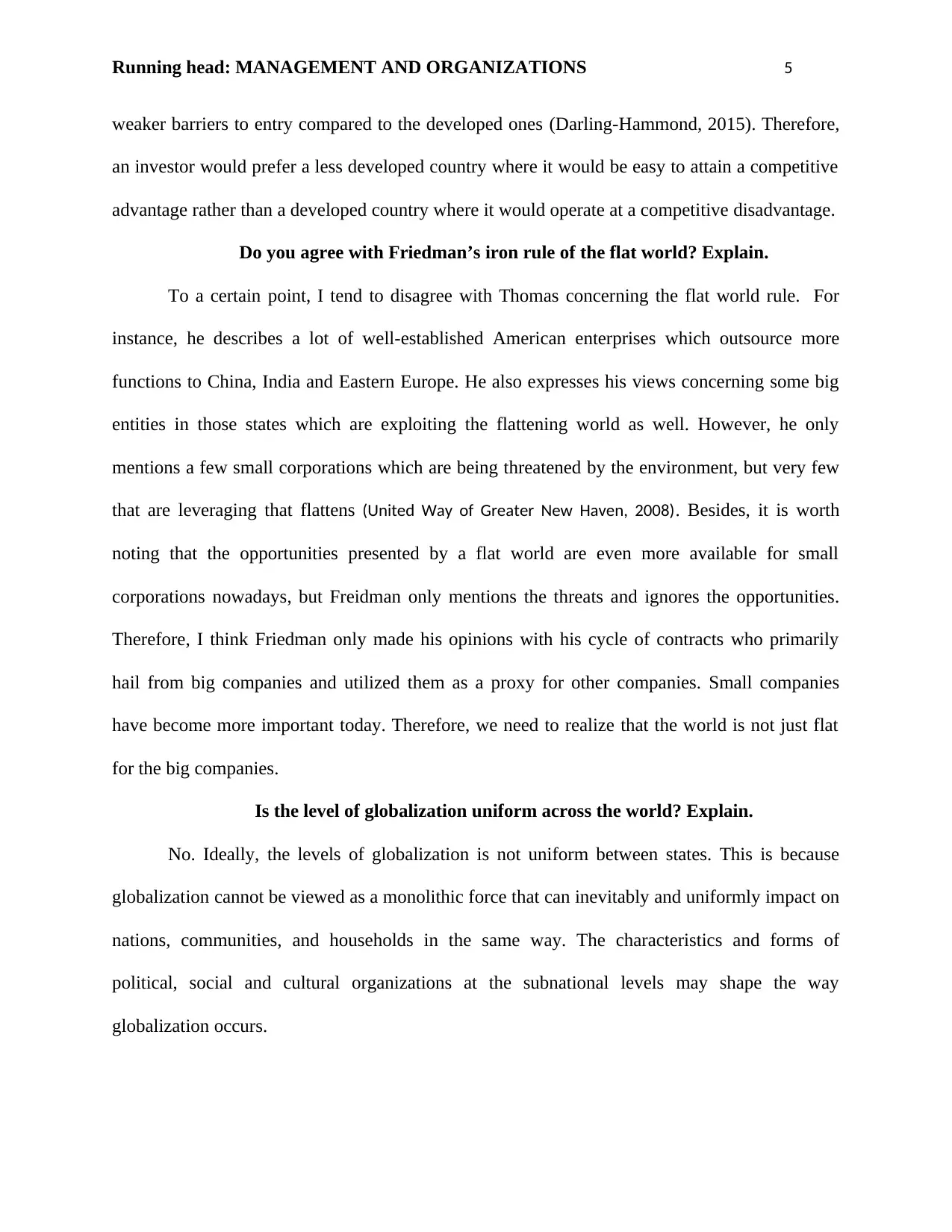
Running head: MANAGEMENT AND ORGANIZATIONS 5
weaker barriers to entry compared to the developed ones (Darling-Hammond, 2015). Therefore,
an investor would prefer a less developed country where it would be easy to attain a competitive
advantage rather than a developed country where it would operate at a competitive disadvantage.
Do you agree with Friedman’s iron rule of the flat world? Explain.
To a certain point, I tend to disagree with Thomas concerning the flat world rule. For
instance, he describes a lot of well-established American enterprises which outsource more
functions to China, India and Eastern Europe. He also expresses his views concerning some big
entities in those states which are exploiting the flattening world as well. However, he only
mentions a few small corporations which are being threatened by the environment, but very few
that are leveraging that flattens (United Way of Greater New Haven, 2008). Besides, it is worth
noting that the opportunities presented by a flat world are even more available for small
corporations nowadays, but Freidman only mentions the threats and ignores the opportunities.
Therefore, I think Friedman only made his opinions with his cycle of contracts who primarily
hail from big companies and utilized them as a proxy for other companies. Small companies
have become more important today. Therefore, we need to realize that the world is not just flat
for the big companies.
Is the level of globalization uniform across the world? Explain.
No. Ideally, the levels of globalization is not uniform between states. This is because
globalization cannot be viewed as a monolithic force that can inevitably and uniformly impact on
nations, communities, and households in the same way. The characteristics and forms of
political, social and cultural organizations at the subnational levels may shape the way
globalization occurs.
weaker barriers to entry compared to the developed ones (Darling-Hammond, 2015). Therefore,
an investor would prefer a less developed country where it would be easy to attain a competitive
advantage rather than a developed country where it would operate at a competitive disadvantage.
Do you agree with Friedman’s iron rule of the flat world? Explain.
To a certain point, I tend to disagree with Thomas concerning the flat world rule. For
instance, he describes a lot of well-established American enterprises which outsource more
functions to China, India and Eastern Europe. He also expresses his views concerning some big
entities in those states which are exploiting the flattening world as well. However, he only
mentions a few small corporations which are being threatened by the environment, but very few
that are leveraging that flattens (United Way of Greater New Haven, 2008). Besides, it is worth
noting that the opportunities presented by a flat world are even more available for small
corporations nowadays, but Freidman only mentions the threats and ignores the opportunities.
Therefore, I think Friedman only made his opinions with his cycle of contracts who primarily
hail from big companies and utilized them as a proxy for other companies. Small companies
have become more important today. Therefore, we need to realize that the world is not just flat
for the big companies.
Is the level of globalization uniform across the world? Explain.
No. Ideally, the levels of globalization is not uniform between states. This is because
globalization cannot be viewed as a monolithic force that can inevitably and uniformly impact on
nations, communities, and households in the same way. The characteristics and forms of
political, social and cultural organizations at the subnational levels may shape the way
globalization occurs.
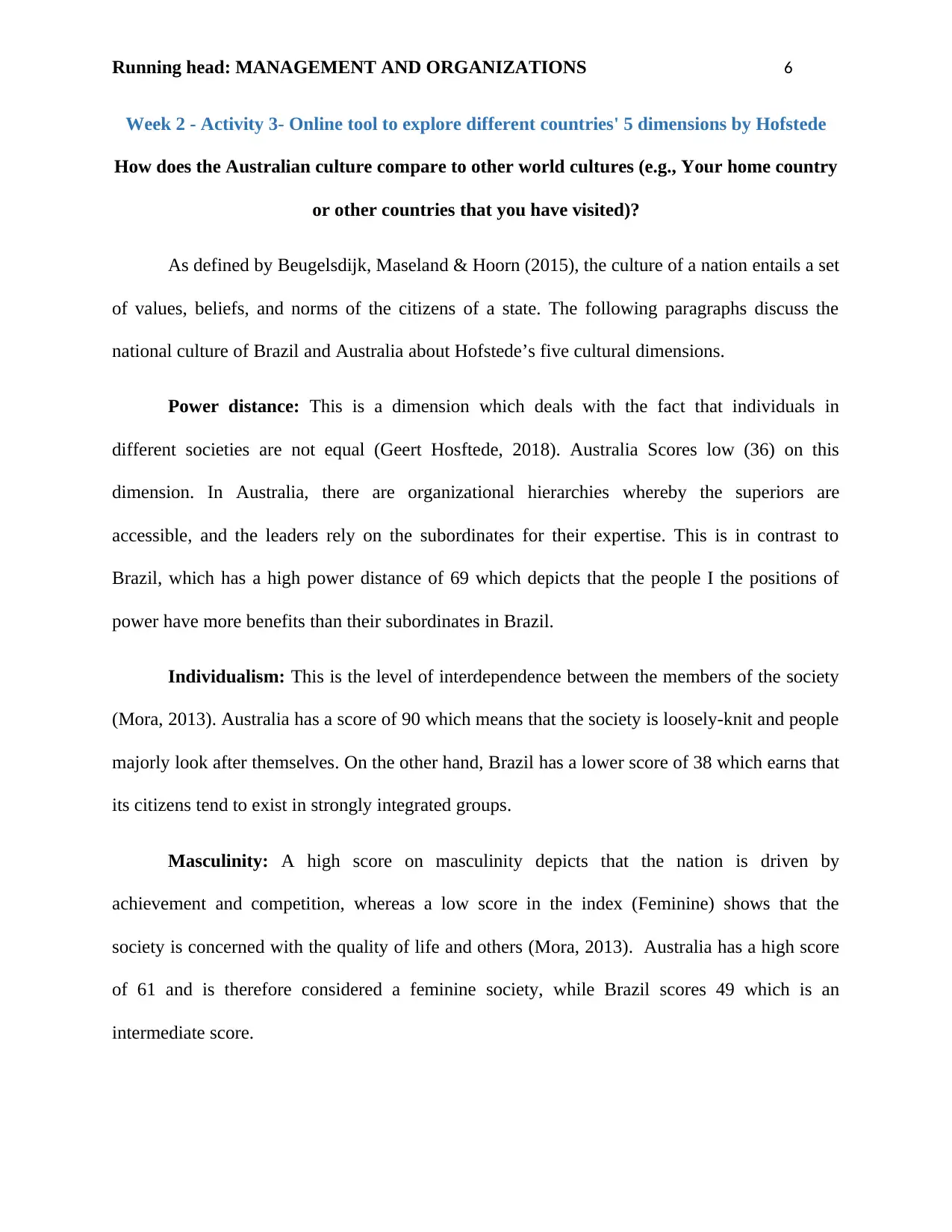
Running head: MANAGEMENT AND ORGANIZATIONS 6
Week 2 - Activity 3- Online tool to explore different countries' 5 dimensions by Hofstede
How does the Australian culture compare to other world cultures (e.g., Your home country
or other countries that you have visited)?
As defined by Beugelsdijk, Maseland & Hoorn (2015), the culture of a nation entails a set
of values, beliefs, and norms of the citizens of a state. The following paragraphs discuss the
national culture of Brazil and Australia about Hofstede’s five cultural dimensions.
Power distance: This is a dimension which deals with the fact that individuals in
different societies are not equal (Geert Hosftede, 2018). Australia Scores low (36) on this
dimension. In Australia, there are organizational hierarchies whereby the superiors are
accessible, and the leaders rely on the subordinates for their expertise. This is in contrast to
Brazil, which has a high power distance of 69 which depicts that the people I the positions of
power have more benefits than their subordinates in Brazil.
Individualism: This is the level of interdependence between the members of the society
(Mora, 2013). Australia has a score of 90 which means that the society is loosely-knit and people
majorly look after themselves. On the other hand, Brazil has a lower score of 38 which earns that
its citizens tend to exist in strongly integrated groups.
Masculinity: A high score on masculinity depicts that the nation is driven by
achievement and competition, whereas a low score in the index (Feminine) shows that the
society is concerned with the quality of life and others (Mora, 2013). Australia has a high score
of 61 and is therefore considered a feminine society, while Brazil scores 49 which is an
intermediate score.
Week 2 - Activity 3- Online tool to explore different countries' 5 dimensions by Hofstede
How does the Australian culture compare to other world cultures (e.g., Your home country
or other countries that you have visited)?
As defined by Beugelsdijk, Maseland & Hoorn (2015), the culture of a nation entails a set
of values, beliefs, and norms of the citizens of a state. The following paragraphs discuss the
national culture of Brazil and Australia about Hofstede’s five cultural dimensions.
Power distance: This is a dimension which deals with the fact that individuals in
different societies are not equal (Geert Hosftede, 2018). Australia Scores low (36) on this
dimension. In Australia, there are organizational hierarchies whereby the superiors are
accessible, and the leaders rely on the subordinates for their expertise. This is in contrast to
Brazil, which has a high power distance of 69 which depicts that the people I the positions of
power have more benefits than their subordinates in Brazil.
Individualism: This is the level of interdependence between the members of the society
(Mora, 2013). Australia has a score of 90 which means that the society is loosely-knit and people
majorly look after themselves. On the other hand, Brazil has a lower score of 38 which earns that
its citizens tend to exist in strongly integrated groups.
Masculinity: A high score on masculinity depicts that the nation is driven by
achievement and competition, whereas a low score in the index (Feminine) shows that the
society is concerned with the quality of life and others (Mora, 2013). Australia has a high score
of 61 and is therefore considered a feminine society, while Brazil scores 49 which is an
intermediate score.
⊘ This is a preview!⊘
Do you want full access?
Subscribe today to unlock all pages.

Trusted by 1+ million students worldwide
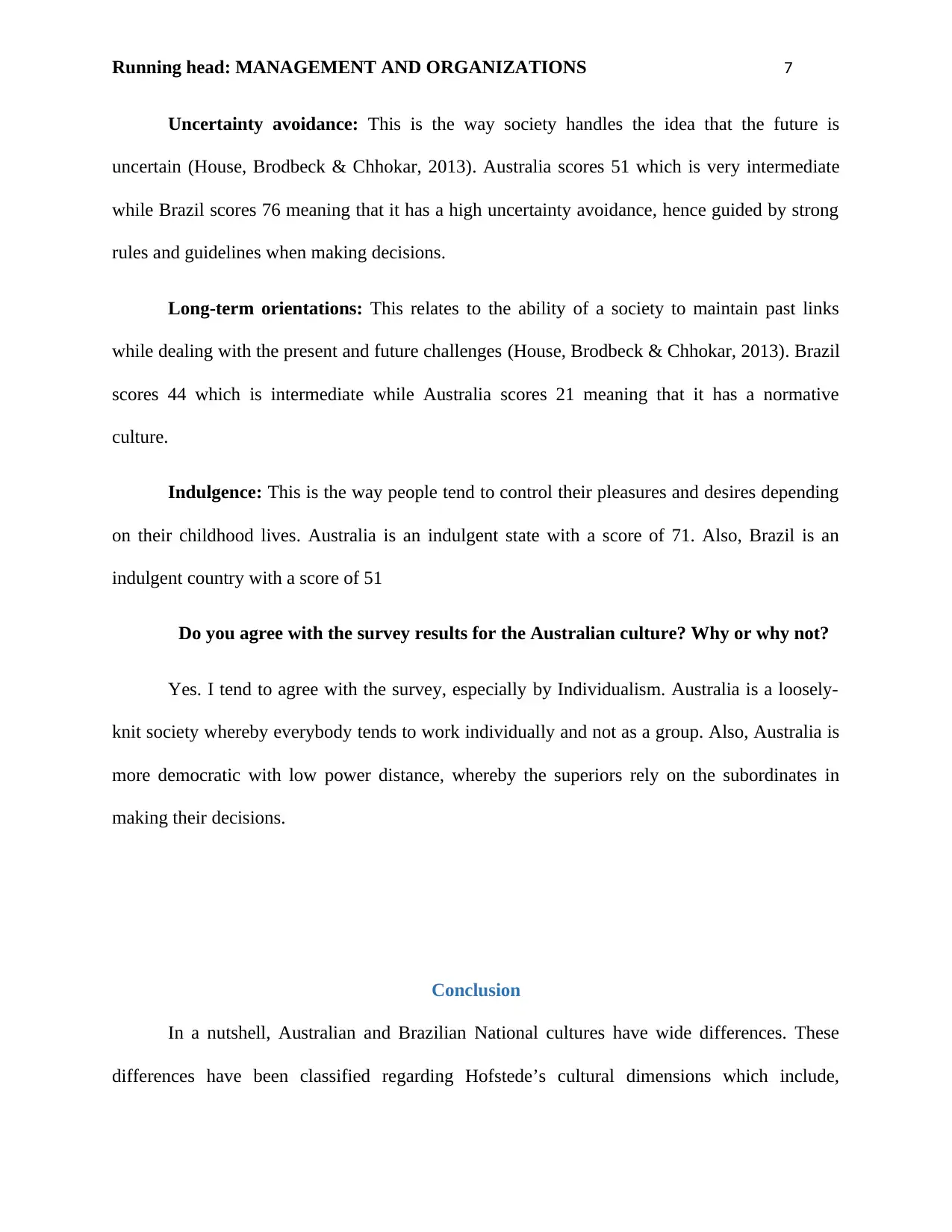
Running head: MANAGEMENT AND ORGANIZATIONS 7
Uncertainty avoidance: This is the way society handles the idea that the future is
uncertain (House, Brodbeck & Chhokar, 2013). Australia scores 51 which is very intermediate
while Brazil scores 76 meaning that it has a high uncertainty avoidance, hence guided by strong
rules and guidelines when making decisions.
Long-term orientations: This relates to the ability of a society to maintain past links
while dealing with the present and future challenges (House, Brodbeck & Chhokar, 2013). Brazil
scores 44 which is intermediate while Australia scores 21 meaning that it has a normative
culture.
Indulgence: This is the way people tend to control their pleasures and desires depending
on their childhood lives. Australia is an indulgent state with a score of 71. Also, Brazil is an
indulgent country with a score of 51
Do you agree with the survey results for the Australian culture? Why or why not?
Yes. I tend to agree with the survey, especially by Individualism. Australia is a loosely-
knit society whereby everybody tends to work individually and not as a group. Also, Australia is
more democratic with low power distance, whereby the superiors rely on the subordinates in
making their decisions.
Conclusion
In a nutshell, Australian and Brazilian National cultures have wide differences. These
differences have been classified regarding Hofstede’s cultural dimensions which include,
Uncertainty avoidance: This is the way society handles the idea that the future is
uncertain (House, Brodbeck & Chhokar, 2013). Australia scores 51 which is very intermediate
while Brazil scores 76 meaning that it has a high uncertainty avoidance, hence guided by strong
rules and guidelines when making decisions.
Long-term orientations: This relates to the ability of a society to maintain past links
while dealing with the present and future challenges (House, Brodbeck & Chhokar, 2013). Brazil
scores 44 which is intermediate while Australia scores 21 meaning that it has a normative
culture.
Indulgence: This is the way people tend to control their pleasures and desires depending
on their childhood lives. Australia is an indulgent state with a score of 71. Also, Brazil is an
indulgent country with a score of 51
Do you agree with the survey results for the Australian culture? Why or why not?
Yes. I tend to agree with the survey, especially by Individualism. Australia is a loosely-
knit society whereby everybody tends to work individually and not as a group. Also, Australia is
more democratic with low power distance, whereby the superiors rely on the subordinates in
making their decisions.
Conclusion
In a nutshell, Australian and Brazilian National cultures have wide differences. These
differences have been classified regarding Hofstede’s cultural dimensions which include,
Paraphrase This Document
Need a fresh take? Get an instant paraphrase of this document with our AI Paraphraser
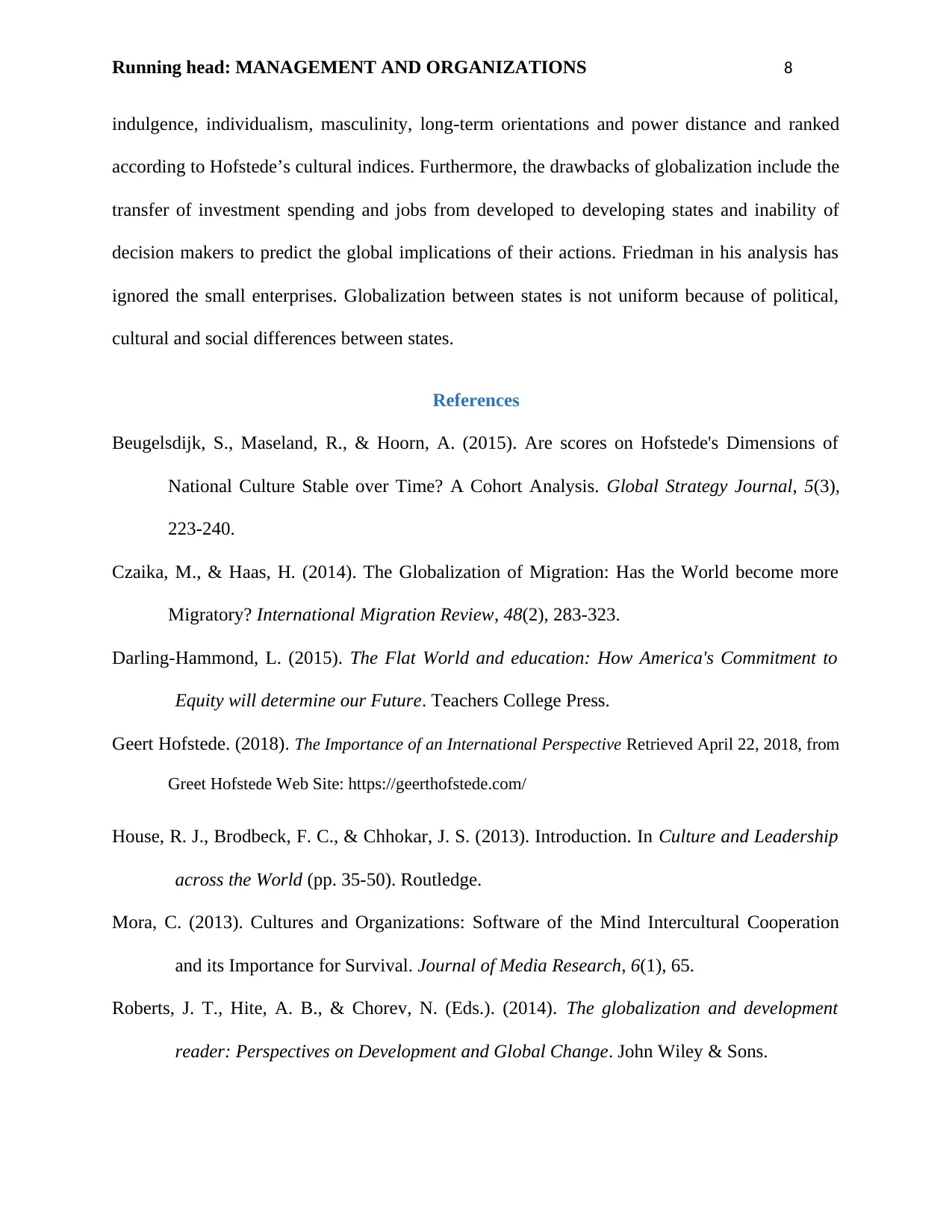
Running head: MANAGEMENT AND ORGANIZATIONS 8
indulgence, individualism, masculinity, long-term orientations and power distance and ranked
according to Hofstede’s cultural indices. Furthermore, the drawbacks of globalization include the
transfer of investment spending and jobs from developed to developing states and inability of
decision makers to predict the global implications of their actions. Friedman in his analysis has
ignored the small enterprises. Globalization between states is not uniform because of political,
cultural and social differences between states.
References
Beugelsdijk, S., Maseland, R., & Hoorn, A. (2015). Are scores on Hofstede's Dimensions of
National Culture Stable over Time? A Cohort Analysis. Global Strategy Journal, 5(3),
223-240.
Czaika, M., & Haas, H. (2014). The Globalization of Migration: Has the World become more
Migratory? International Migration Review, 48(2), 283-323.
Darling-Hammond, L. (2015). The Flat World and education: How America's Commitment to
Equity will determine our Future. Teachers College Press.
Geert Hofstede. (2018). The Importance of an International Perspective Retrieved April 22, 2018, from
Greet Hofstede Web Site: https://geerthofstede.com/
House, R. J., Brodbeck, F. C., & Chhokar, J. S. (2013). Introduction. In Culture and Leadership
across the World (pp. 35-50). Routledge.
Mora, C. (2013). Cultures and Organizations: Software of the Mind Intercultural Cooperation
and its Importance for Survival. Journal of Media Research, 6(1), 65.
Roberts, J. T., Hite, A. B., & Chorev, N. (Eds.). (2014). The globalization and development
reader: Perspectives on Development and Global Change. John Wiley & Sons.
indulgence, individualism, masculinity, long-term orientations and power distance and ranked
according to Hofstede’s cultural indices. Furthermore, the drawbacks of globalization include the
transfer of investment spending and jobs from developed to developing states and inability of
decision makers to predict the global implications of their actions. Friedman in his analysis has
ignored the small enterprises. Globalization between states is not uniform because of political,
cultural and social differences between states.
References
Beugelsdijk, S., Maseland, R., & Hoorn, A. (2015). Are scores on Hofstede's Dimensions of
National Culture Stable over Time? A Cohort Analysis. Global Strategy Journal, 5(3),
223-240.
Czaika, M., & Haas, H. (2014). The Globalization of Migration: Has the World become more
Migratory? International Migration Review, 48(2), 283-323.
Darling-Hammond, L. (2015). The Flat World and education: How America's Commitment to
Equity will determine our Future. Teachers College Press.
Geert Hofstede. (2018). The Importance of an International Perspective Retrieved April 22, 2018, from
Greet Hofstede Web Site: https://geerthofstede.com/
House, R. J., Brodbeck, F. C., & Chhokar, J. S. (2013). Introduction. In Culture and Leadership
across the World (pp. 35-50). Routledge.
Mora, C. (2013). Cultures and Organizations: Software of the Mind Intercultural Cooperation
and its Importance for Survival. Journal of Media Research, 6(1), 65.
Roberts, J. T., Hite, A. B., & Chorev, N. (Eds.). (2014). The globalization and development
reader: Perspectives on Development and Global Change. John Wiley & Sons.

Running head: MANAGEMENT AND ORGANIZATIONS 9
United Way of Greater New Haven. 2008. Thomas Friedman's Three Eras of Globalization. [Video File]
Retrieved From https://www.youtube.com/watch?v=lp4znWHvsjU
United Way of Greater New Haven. 2008. Thomas Friedman's Three Eras of Globalization. [Video File]
Retrieved From https://www.youtube.com/watch?v=lp4znWHvsjU
⊘ This is a preview!⊘
Do you want full access?
Subscribe today to unlock all pages.

Trusted by 1+ million students worldwide
1 out of 9
Related Documents
Your All-in-One AI-Powered Toolkit for Academic Success.
+13062052269
info@desklib.com
Available 24*7 on WhatsApp / Email
![[object Object]](/_next/static/media/star-bottom.7253800d.svg)
Unlock your academic potential
Copyright © 2020–2025 A2Z Services. All Rights Reserved. Developed and managed by ZUCOL.


